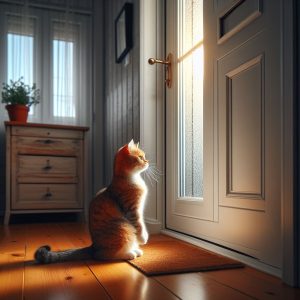Is your cat eating and drinking normally but not peeing? This common feline health issue can have pet parents extremely concerned. After all, if your furry friend isn’t peeing, where is all that consumed food and water going?
Not being able to pee is very serious for cats. It can quickly lead to potentially fatal illnesses. So if your cat is eating and drinking but not peeing, you need to take action fast.
In this comprehensive guide, we’ll cover all the possible reasons your cat isn’t peeing along with actionable solutions. Read on to learn what might cause this distressing symptom, how to get your kitty to pee again, and when to see the vet immediately.
Common Causes of Litter Box Avoidance
There are a number of reasons why a cat might avoid the litter box even if they are eating and drinking normally. Here are some of the most common causes of litter box avoidance in cats:
Urinary Tract Infection
One of the most frequent causes of painful peeing in cats is a urinary tract infection (UTI). The symptoms include:
- Frequent trips to the litter box but little success peeing
- Crying or straining while trying to pee
- Passing small amounts of urine
- Blood in the urine
- Excessive licking of genital area
UTIs occur when bacteria gets into the bladder and reproduces rapidly. This leads to inflammation, irritation, and a burning sensation when peeing.
Treatment: UTIs are usually treated with a course of antibiotics prescribed by a vet. Ensuring your cat drinks plenty of water can help flush out bacteria from the urinary tract. Vets may recommend prescription urinary tract food or supplements as well.
Bladder or Kidney Stones
Crystals or stones in the bladder or kidneys can cause a partial or complete blockage that prevents urine from passing out of the body. This is a particular risk for male cats since their urethra is narrow. Symptoms include:
- Crying out in pain
- Straining to pee
- Bloody urine
- Reduced urination
- Lethargy, nausea, and vomiting
Treatment: Removal of the stones through surgery or a special diet to dissolve the stones. Encouraging water intake can help prevent crystals from forming. Prescription urinary tract cat food may be recommended.
Stress and Anxiety
Cats are easily stressed and anxious. A stressful home environment or changes in routine can cause a cat to avoid the litter box. Signs include:
- Using locations other than the litter box
- Excessive grooming
- Aggression
- Hiding more than usual
Treatment: Figure out and eliminate the source of stress. Add more litter boxes in quiet, low-traffic areas. Try calming pheromone diffusers. Clean litter boxes frequently to encourage use.
Constipation
If your cat isn’t drinking enough water, constipation can result. They may avoid the litter box because the act of peeing is painful. Symptoms include:
- Crying or straining when trying to poop
- Hard, dry stools
- Infrequent bowel movements
- Loss of appetite
Treatment: Make sure fresh water is always available. Add moisture to food with wet food or broths. Slowly increase fiber intake to ease constipation. Consult a vet for laxatives if needed.
Inflammation and Tumors
Medical conditions like feline lower urinary tract disease (FLUTD), diabetes, and cancer can cause inflammation, sores, and pressure on the bladder. This restricts urine flow causing litter box avoidance. Symptoms are:
- Frequent attempts to pee
- Blood in urine
- Vocalizing pain or discomfort
Treatment: Diagnostic tests like x-rays, ultrasound, urinalysis and bloodwork to determine the underlying cause. Treatment will depend on the specific condition.
Kidney Disease
Kidney disease is common in older cats and can make urination very painful. Symptoms include:
- Increased thirst and urination
- Urinating outside the litter box
- Bloody or cloudy urine
- Weight loss, appetite loss
Treatment: There is no cure for chronic kidney disease. Treatment focuses on managing symptoms with medications, intravenous fluids, and special kidney-friendly cat food.
Feline Lower Urinary Tract Disease (FLUTD)
This refers to a variety of conditions that affect the bladder and urethra such as infections, stones, tumors or strictures. Symptoms include:
- Frequent attempts to urinate
- Excessive licking of genital area
- Blood in urine
- Crying out while peeing
Treatment: Identifying the specific condition causing FLUTD through urinalysis and imaging tests. Treatment varies based on underlying cause.
Litter Box Preferences
Some cats are very particular about the litter box environment. Avoidance may happen if the box is too dirty, the litter texture has changed, or the location is undesirable. Cats may also begin to associate the box with pain while peeing and avoid it. Try the following:
- Different litter material like pine, wheat or crystal litters
- Add more litter boxes in quiet locations
- Separate food and water from litter boxes
- Clean boxes twice daily
- Use attractant litters
- Try uncovered boxes
- Use larger boxes
When to See the Vet Immediately
While simple litter box fixes can resolve some peeing issues, others require immediate medical intervention. Seek emergency vet care if your cat is unable to pee at all or exhibiting these symptoms:
✔ Crying out in pain while trying to pee
✔ Bloody, cloudy, or foul-smelling urine
✔ Straining or discomfort when peeing
✔ Fever, lethargy, vomiting
✔ Constant trips to litter box with no results
✔ Loss of appetite
Cats are excellent at masking illness. Drastic changes in peeing habits coupled with the above symptoms can indicate potentially fatal issues like a urethral obstruction or toxin buildup. Waiting too long can have grave consequences.
Diagnosing Why Your Cat Isn’t Peeing
To get to the root cause of litter box avoidance, the following diagnostic tests may be performed:
- Physical exam – check for signs of pain and palpate the bladder
- Urinalysis – tests urine for infection, crystals, blood
- Bloodwork – evaluates kidney function, diabetes, etc.
- Urine culture – identifies bacteria causing UTI
- Imaging – X-rays or ultrasound to check for stones, tumors
Based on initial test results, additional diagnostics like microscopy of bladder wall cells or bladder endoscopy may be warranted.
How to Get Your Cat to Pee Again
Once you and your vet have determined the underlying issue behind your cat not peeing, treatment can begin. Here are some general tips to encourage litter box use again:
Increase Water Intake
Staying hydrated is key for proper urinary tract health. Here’s how to get more water into your cat:
- Give wet/canned food instead of only dry
- Add water, broth or tuna juice to food
- Use a pet drinking fountain
- Offer flavored waters like tuna water
- Feed cats separately to prevent competition
Urinary Tract Cat Food
There are specialty prescription urinary tract diets formulated to promote urinary health. They typically contain:
- Added moisture to increase water consumption
- Increased sodium to encourage drinking
- Reduced magnesium and phosphorus to prevent crystals
- Omega-3 fatty acids to reduce inflammation
- Added antioxidants like Vitamin E
Discuss with your vet if one of these foods could benefit your cat.
Address Underlying Medical Issues
Follow prescribed treatment plans for conditions like UTIs, kidney disease, diabetes, etc. Give all medication as directed. Monitor cat for improvement. Report any concerns immediately.
Encourage Litter Box Use
Make the litter box appealing again so your cat feels comfortable peeing there.
- Use attractant litters
- Add more litter boxes in quiet spots
- Try different litter textures
- Use uncovered boxes
- Clean box twice daily
- Don’t scold for accidents
Reduce Stress Triggers
Determine what is causing your cat stress and try to mitigate it. Common stressors are:
- New animals or people in home
- Loud noises like construction
- Changes to their routine or environment
- Children or guests chasing them
- Bullying from other pets
Using calming aids like pheromone diffusers or calming treats/supplements can also lower stress.
Seek Second Opinion
If your cat is still unable to pee after initial treatment, get a second opinion from another vet or veterinary specialist. There may be an underlying condition that hasn’t been diagnosed yet.
When to Seek Emergency Care for Cat Not Peeing
Monitor your cat closely even after starting treatment. Immediate emergency care is vital if you notice:
- No urination at all for 24+ hours
- Visible discomfort or crying when trying to pee
- Constant trips to litter box with no results
- Loss of appetite or lethargy
- Vomiting or other signs of toxin buildup
A veterinary ER can provide intravenous fluids, pain management and diagnostics to determine if there is a dangerous obstruction requiring emergency surgery.
Don’t delay. A cat not peeing is a cat in danger!
FAQs: Cat Eating and Drinking But Not Peeing
Here are answers to some frequently asked questions about cats unable to pee:
Q: Are male or female cats more prone to urinary issues?
A: Male cats are at greater risk as their urethra is narrower. This makes obstruction from stones, masses or strictures more likely.
Q: What emergency steps can I take if my cat hasn’t peed in over 24 hours?
A: Seek vet care immediately. In the meantime, try gently massaging the lower abdomen to relieve pressure on the bladder. Do not try to manually express urine.
Q: Could litter box avoidance be a sign of feline cognitive dysfunction?
A: Yes, cats with cognitive decline may forget litter box training. Try placing food and water near box to trigger instinct to pee/poop away from food.
Q: My cat had a UTI last month. Could a new UTI cause not peeing again?
A: Absolutely. Recurrent UTIs are common in cats. Follow up with your vet to confirm if infection has returned.
Q: What natural supplements can promote urinary tract health in cats?
A: Cranberry, D-mannose and glutamine supplements have been shown to help prevent and treat feline urinary issues. Ask your vet before starting.
The Takeaway on Cat Not Peeing: Call the Vet ASAP
Not urinating is a major red flag when it comes to your cat’s health. While there could be simple solutions like adding a litter box or switching litters, painful urination and litter box avoidance can also indicate severe medical issues.
Contact your veterinarian promptly if your cat stops peeing. Be prepared to describe all symptoms in detail. Quick diagnosis and treatment are crucial to support kidney function and prevent the cat’s condition from declining into potentially fatal territory.
With veterinary intervention and an at-home care plan focused on enticing your cat back to the litter box, you can get your furry pal peeing properly again. Stay vigilant for any signs of recurrence and continue providing a stress-free, enticing environment to potty.
Here’s to happier, hassle-free pees for your precious feline companion!



